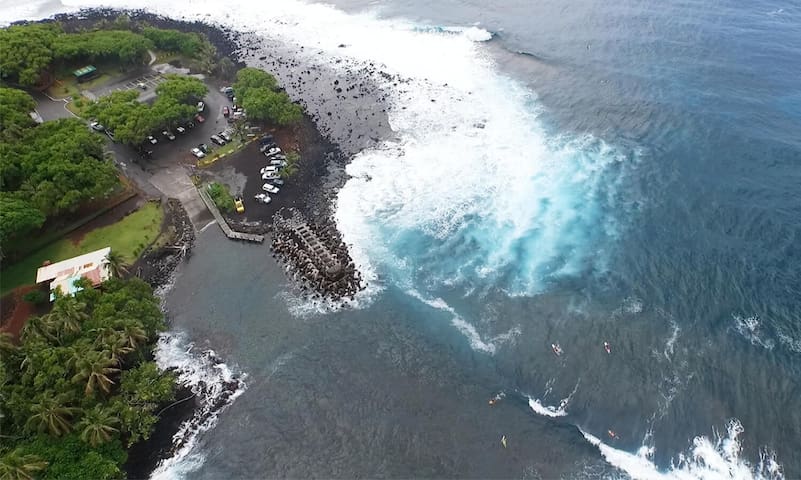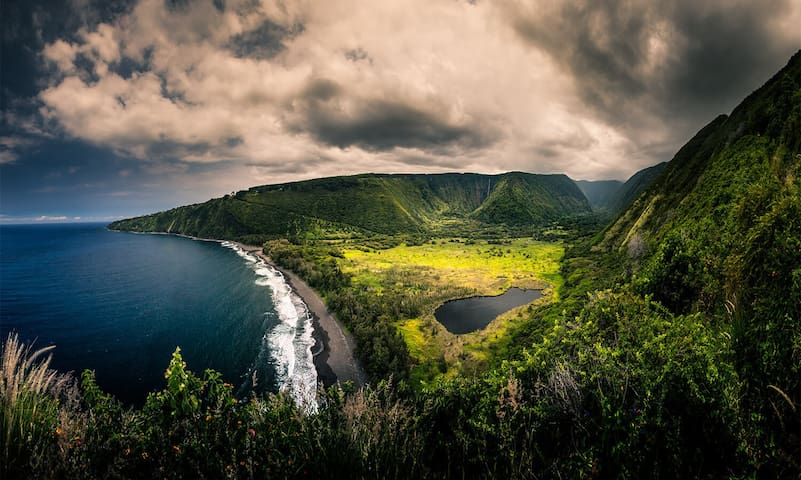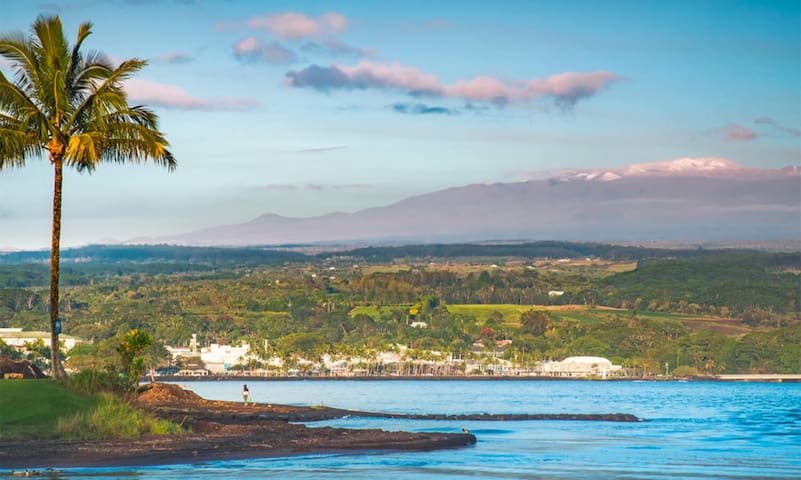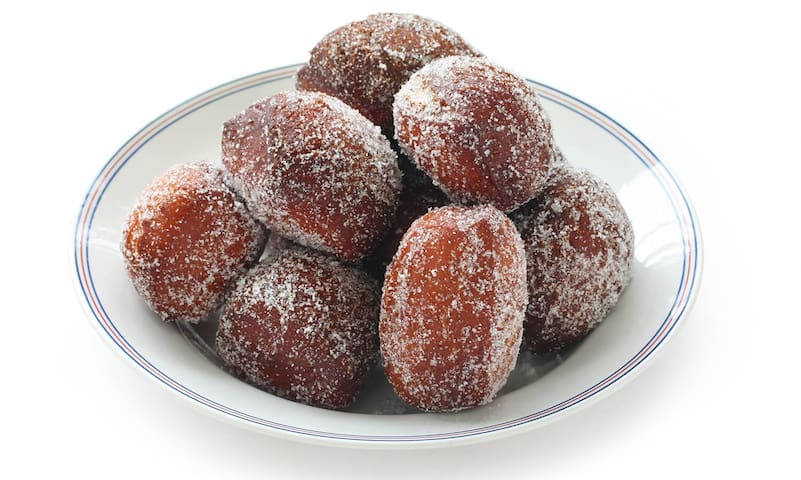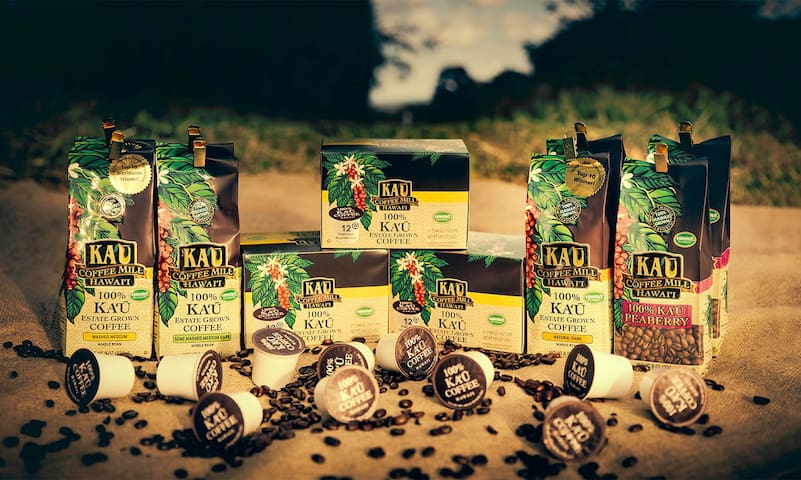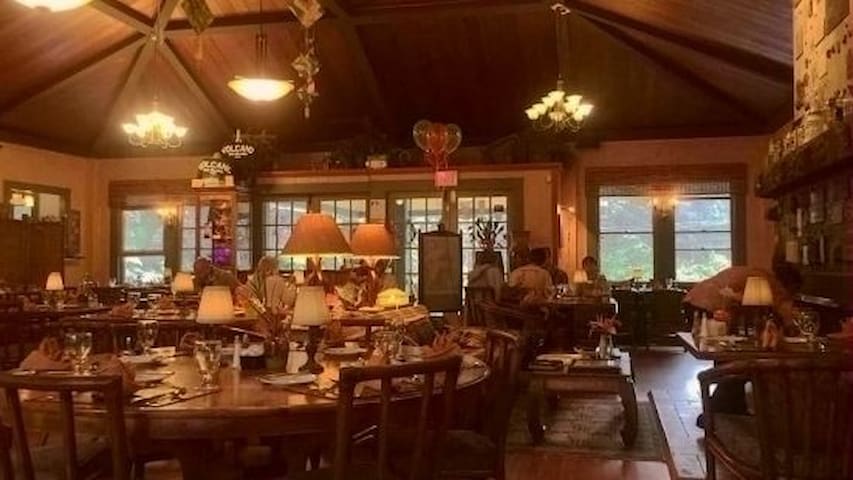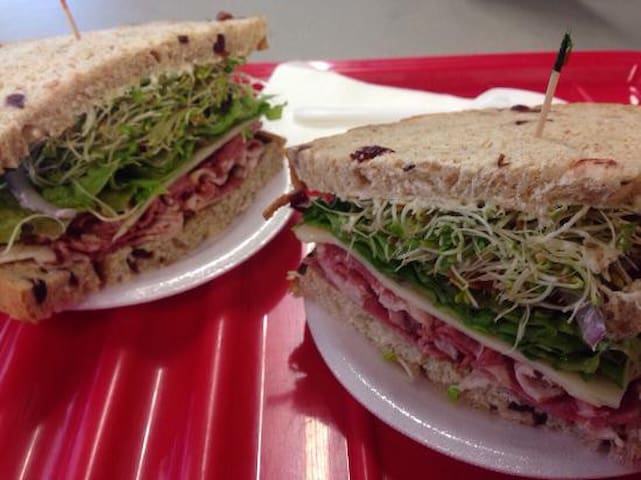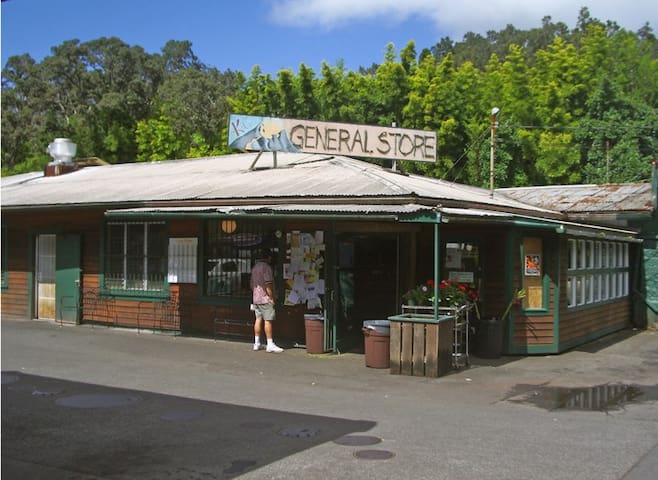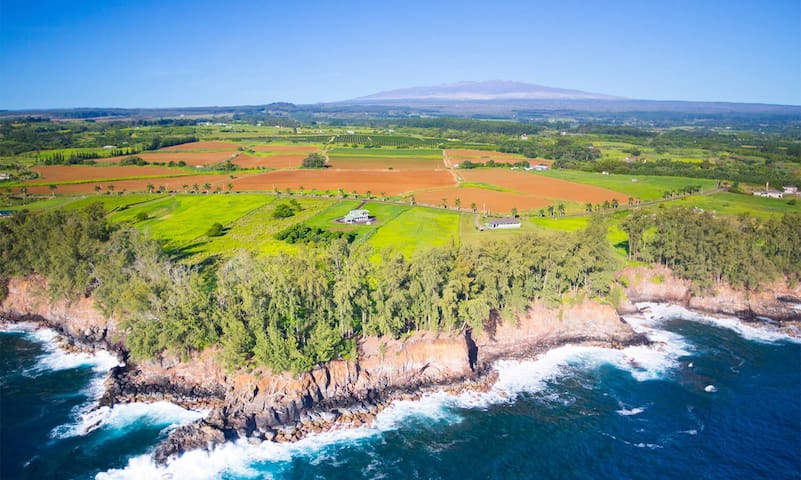Sightseeing
Punalu'u beach is just off Highway 11, and 31 miles south of Volcano Village as you drive towards South Point. It is the most accessible of the island’s black sand beaches, and important as a nesting beach for the critically-endangered hawksbill sea turtle. Hawksbills are rarely seen, however. Instead, it is the much more common Hawaiian green sea turtle you are likely to see here, grazing on algae that grows on the shiny black rocks. The glittering black sands underneath the green coconut palms and against the dark blue ocean are simply breathtaking.
175 recommandé par les habitants
Punalu‘u Beach
Punalu'u beach is just off Highway 11, and 31 miles south of Volcano Village as you drive towards South Point. It is the most accessible of the island’s black sand beaches, and important as a nesting beach for the critically-endangered hawksbill sea turtle. Hawksbills are rarely seen, however. Instead, it is the much more common Hawaiian green sea turtle you are likely to see here, grazing on algae that grows on the shiny black rocks. The glittering black sands underneath the green coconut palms and against the dark blue ocean are simply breathtaking.
The southernmost point of the Big Island, and also the southernmost point of the United States, is called Ka Lae in Hawaiian: The Point. It can be reached after a 49 mile drive south from Volcano Village. Here, the cliffs are high and steep, and the water clear, blue, and dangerous with enormous currents. Still, some people are tempted to jump from the cliffs for fun. Ka Lae is known to local fishermen for excellent fishing, as the deep currents bring valuable sportfish close to the cliffs. Many visit here to experience a green sand beach made of olivine crystals. From the parking area, the walk to the green sand beach is about two miles in the full sun and, often, a strong wind. Dress appropriately and bring drinking water.
18 recommandé par les habitants
Kalae
The southernmost point of the Big Island, and also the southernmost point of the United States, is called Ka Lae in Hawaiian: The Point. It can be reached after a 49 mile drive south from Volcano Village. Here, the cliffs are high and steep, and the water clear, blue, and dangerous with enormous currents. Still, some people are tempted to jump from the cliffs for fun. Ka Lae is known to local fishermen for excellent fishing, as the deep currents bring valuable sportfish close to the cliffs. Many visit here to experience a green sand beach made of olivine crystals. From the parking area, the walk to the green sand beach is about two miles in the full sun and, often, a strong wind. Dress appropriately and bring drinking water.
Pohoiki, also known as Isaac Hale Beach Park, was the area’s primary boat ramp before the 2018 eruption. Vast lava flows covered roads and cut off access to Pohoiki during the eruption, and many feared the boat ramp and popular beach park would be overrun as well. However, the flows stopped on the literal margins of the beach park and spared it. To the surprise of residents, the boat ramp was instead inundated by brand new black sand, created by the explosion of hot lava as it entered the cool sea. The black sand was so voluminous that it overwhelmed the boat ramp area and continued down the coast to make a new, sparkling, black sand beach. Pohoiki is 45 miles from Volcano Village.
Pohoiki Road
Pohoiki RoadPohoiki, also known as Isaac Hale Beach Park, was the area’s primary boat ramp before the 2018 eruption. Vast lava flows covered roads and cut off access to Pohoiki during the eruption, and many feared the boat ramp and popular beach park would be overrun as well. However, the flows stopped on the literal margins of the beach park and spared it. To the surprise of residents, the boat ramp was instead inundated by brand new black sand, created by the explosion of hot lava as it entered the cool sea. The black sand was so voluminous that it overwhelmed the boat ramp area and continued down the coast to make a new, sparkling, black sand beach. Pohoiki is 45 miles from Volcano Village.
Storied Waipiʻo Valley, at the end of Hamakua Heritage Corridor, can be experienced either from the overlook into the enormous valley below, or from the valley floor, which can be reached with 4WD vehicles only. The small, steep, slippery road into the valley is intimidating, so if you have any concerns, sign on with a tour company to enter the valley, or walk down and up on the road. The valley is stunning, five miles deep and surrounded by steep green cliffs that rise well over a thousand feet high. Visitors can walk the black sand beach, explore the stream, take a horseback ride, or enjoy all of these options on a package tour. Waipiʻo Valley is 79 miles from Volcano Village, and well worth the drive. People live and work in Waipiʻo, and the local code of conduct is to behave respectfully around their farms and lands.
117 recommandé par les habitants
Waipio Valley
Storied Waipiʻo Valley, at the end of Hamakua Heritage Corridor, can be experienced either from the overlook into the enormous valley below, or from the valley floor, which can be reached with 4WD vehicles only. The small, steep, slippery road into the valley is intimidating, so if you have any concerns, sign on with a tour company to enter the valley, or walk down and up on the road. The valley is stunning, five miles deep and surrounded by steep green cliffs that rise well over a thousand feet high. Visitors can walk the black sand beach, explore the stream, take a horseback ride, or enjoy all of these options on a package tour. Waipiʻo Valley is 79 miles from Volcano Village, and well worth the drive. People live and work in Waipiʻo, and the local code of conduct is to behave respectfully around their farms and lands.
Pololū Valley is the farthest north of the valleys carved by millenia of rain into the eastern-facing flank of Kohala volcano (extinct), and thought of by many as the “smaller Waipiʻo”. Because one must travel through the towns of Waimea and Hawi to reach the Pololū lookout and parking area, it is 113 miles away from Volcano Village. A trail, sometimes muddy, rapidly descends to the valley floor and a small stream, easily crossed, runs from the valley wetlands into the sea. Visitors and locals hike, camp, and—if the ocean is very calm—swim or surf here. The beach is black sand, and one can continue on the trail to the other side of the valley, then climb that side for spectacular views of the coastline.
140 recommandé par les habitants
Pololu Valley
Pololū Valley is the farthest north of the valleys carved by millenia of rain into the eastern-facing flank of Kohala volcano (extinct), and thought of by many as the “smaller Waipiʻo”. Because one must travel through the towns of Waimea and Hawi to reach the Pololū lookout and parking area, it is 113 miles away from Volcano Village. A trail, sometimes muddy, rapidly descends to the valley floor and a small stream, easily crossed, runs from the valley wetlands into the sea. Visitors and locals hike, camp, and—if the ocean is very calm—swim or surf here. The beach is black sand, and one can continue on the trail to the other side of the valley, then climb that side for spectacular views of the coastline.
Maunakea volcano is the tallest mountain on the Earth, about 30,000ft. high as measured from the seabed, and is a fantastic place to stargaze. Because of the remote location of this destination, make sure to top up your gas tank in Hilo before you go. Many of the finest telescopes in the world are situated here, and the Onizuka Center for International Astronomy Visitor Information Center sits about halfway to the summit, at around 9,200ft above sea level.
Getting There
Take the turn to the visitor center from Saddle Road around mile marker 28. It is well-signed. There are often astronomy talks at the visitor center that are free and open to the public. There are also many private tours designed just to experience stargazing here. From the visitor center, you must have a 4WD vehicle to proceed to the 13,796ft. summit.
Driving to the Summit
If you mean to drive to the summit, spend at least a half an hour at the visitor center to acclimatize, as travelling upwards too quickly can cause serious health risks. Also: this unpaved road may be closed if there are hazardous wind, ice, or snow conditions. If you do reach the summit and the weather is clear, the views are unparalleled. Staying here for sunset is one of the most memorable things you can do.
Recommendations
The observatories will be closed to public access, but the summit itself is open to visitors until half an hour after sunset. Dress warmly, as temperatures at this altitude are often near 30 degrees F even on a clear day, and plummet once the sun goes down. A good way to plan your visit is to visit the summit first, then arrive back down at the visitor center for stargazing and any astronomy talks that may be in progress.
25 recommandé par les habitants
Mauna Kea
Maunakea volcano is the tallest mountain on the Earth, about 30,000ft. high as measured from the seabed, and is a fantastic place to stargaze. Because of the remote location of this destination, make sure to top up your gas tank in Hilo before you go. Many of the finest telescopes in the world are situated here, and the Onizuka Center for International Astronomy Visitor Information Center sits about halfway to the summit, at around 9,200ft above sea level.
Getting There
Take the turn to the visitor center from Saddle Road around mile marker 28. It is well-signed. There are often astronomy talks at the visitor center that are free and open to the public. There are also many private tours designed just to experience stargazing here. From the visitor center, you must have a 4WD vehicle to proceed to the 13,796ft. summit.
Driving to the Summit
If you mean to drive to the summit, spend at least a half an hour at the visitor center to acclimatize, as travelling upwards too quickly can cause serious health risks. Also: this unpaved road may be closed if there are hazardous wind, ice, or snow conditions. If you do reach the summit and the weather is clear, the views are unparalleled. Staying here for sunset is one of the most memorable things you can do.
Recommendations
The observatories will be closed to public access, but the summit itself is open to visitors until half an hour after sunset. Dress warmly, as temperatures at this altitude are often near 30 degrees F even on a clear day, and plummet once the sun goes down. A good way to plan your visit is to visit the summit first, then arrive back down at the visitor center for stargazing and any astronomy talks that may be in progress.
The park entrance is located less than a mile from the intersection of most Volcano Village streets with Highway 11. It is open 24 hours a day, with fee collection stations usually manned from about 7 a.m. to about 4 p.m., every day. If the fee station is not open, there are stations at which you may pay the fee to receive your parking receipt. Entrance fees are currently:
$25.00 per private non-commercial vehicle (capacity 15 or less) - 7 days
$12.00 per pedestrian or bicycle - 7 days
$20.00 per motorcycle - 7 days
$50.00 Hawai‘i Tri-park Annual Pass
880 recommandé par les habitants
Hawaii Volcanoes National Park
The park entrance is located less than a mile from the intersection of most Volcano Village streets with Highway 11. It is open 24 hours a day, with fee collection stations usually manned from about 7 a.m. to about 4 p.m., every day. If the fee station is not open, there are stations at which you may pay the fee to receive your parking receipt. Entrance fees are currently:
$25.00 per private non-commercial vehicle (capacity 15 or less) - 7 days
$12.00 per pedestrian or bicycle - 7 days
$20.00 per motorcycle - 7 days
$50.00 Hawai‘i Tri-park Annual Pass
The Mauna Ulu trailhead, located along Chain of Craters Road, is approximately 7 miles from the park visitor center. The trail begins about 100 yards from the parking lot. Here, you can walk across the rolling pahoehoe lava fields deposited by the large eruptive vent called Mauna Ulu, in front of you, in the late 1960s and early 1970s. Small native ʻōhiʻa trees are just beginning to recolonize the lava field. The round-trip to the 210ft. summit of Puʻu Huluhulu is 2.5 miles, of which most are on the exposed lava field, so dress for sun and rain as both can happen in quick succession. The trail is marked by rock cairns, called “ahu” in Hawaiʻi. The views from the top of the hill are stunning on a clear day, encompassing not only the ominously steaming shield of nearby Mauna Ulu, but also Mauna Loa, distant Maunkea, the summit caldera of Kīlauea, and even the blue Pacific Ocean.
Mauna Ulu
The Mauna Ulu trailhead, located along Chain of Craters Road, is approximately 7 miles from the park visitor center. The trail begins about 100 yards from the parking lot. Here, you can walk across the rolling pahoehoe lava fields deposited by the large eruptive vent called Mauna Ulu, in front of you, in the late 1960s and early 1970s. Small native ʻōhiʻa trees are just beginning to recolonize the lava field. The round-trip to the 210ft. summit of Puʻu Huluhulu is 2.5 miles, of which most are on the exposed lava field, so dress for sun and rain as both can happen in quick succession. The trail is marked by rock cairns, called “ahu” in Hawaiʻi. The views from the top of the hill are stunning on a clear day, encompassing not only the ominously steaming shield of nearby Mauna Ulu, but also Mauna Loa, distant Maunkea, the summit caldera of Kīlauea, and even the blue Pacific Ocean.
The Volcano Art Center (VAC) is easily located next to the national park visitor center, and is housed in what was once the original 1877 Volcano House Hotel. A wander through the gallery within the wooden doors will open up a rich world of Hawaiian art and culture, with paintings, glass-blown art, photography, jewelry, limited edition prints, notecards, silk scarves, and one of a kind art pieces in native or natural materials. The VAC is a nonprofit organization that was started in the mid-1970s by local artists, and now features nearly 250 local artists. Kīlauea volcano, and the volcano deity Pele, are strong inspirations for the works found here. Other subjects include the art and craft of hula, native plants and animals, legends and myths of Hawaiʻi, and aspects of ancient and modern Hawaiian culture.
14 recommandé par les habitants
Volcano Art Center - Hale Ho'omana
19-4074 Old Volcano RdThe Volcano Art Center (VAC) is easily located next to the national park visitor center, and is housed in what was once the original 1877 Volcano House Hotel. A wander through the gallery within the wooden doors will open up a rich world of Hawaiian art and culture, with paintings, glass-blown art, photography, jewelry, limited edition prints, notecards, silk scarves, and one of a kind art pieces in native or natural materials. The VAC is a nonprofit organization that was started in the mid-1970s by local artists, and now features nearly 250 local artists. Kīlauea volcano, and the volcano deity Pele, are strong inspirations for the works found here. Other subjects include the art and craft of hula, native plants and animals, legends and myths of Hawaiʻi, and aspects of ancient and modern Hawaiian culture.
City/town information
The small, funky town of Pāhoa, 32 miles from Volcano Village, was untouched by the 2018 eruption, at least directly, and features several very good restaurants, as well as a natural foods store, and a farmerʻs market on weekends. It is rapidly growing, as the Puna District is the fastest growing region in Hawaiʻi. Vintage, plantation-era buildings house eclectic local shops and the locals are colorful and laid back. Those wishing to support the recovering Puna community can do so by spending their travel dollars in and around Pāhoa.
103 recommandé par les habitants
Pāhoa
The small, funky town of Pāhoa, 32 miles from Volcano Village, was untouched by the 2018 eruption, at least directly, and features several very good restaurants, as well as a natural foods store, and a farmerʻs market on weekends. It is rapidly growing, as the Puna District is the fastest growing region in Hawaiʻi. Vintage, plantation-era buildings house eclectic local shops and the locals are colorful and laid back. Those wishing to support the recovering Puna community can do so by spending their travel dollars in and around Pāhoa.
Downtown Hilo, 40 minutes north of Volcano, is lush and green, with large parks and a historic district full of interesting shops and small eateries with wonderful food from some of the many ethnicities that call Hilo home. It is famous for its near-daily rainbows and warm, friendly local culture. A short drive north of Hilo will take you past the popular surf spot of Honoliʻi and up to gorgeous Akaka Falls. Hilo itself boasts the Imiloa Astronomy Center, the Mokupāpapa Discovery Center, The Pacific Tsunami Museum, and numerous galleries and coffeehouses. Dinner choices run from Vietnamese to Indian to Italian cuisines. History buffs will enjoy the plantation-era Lyman House Museum.
120 recommandé par les habitants
Hilo
Downtown Hilo, 40 minutes north of Volcano, is lush and green, with large parks and a historic district full of interesting shops and small eateries with wonderful food from some of the many ethnicities that call Hilo home. It is famous for its near-daily rainbows and warm, friendly local culture. A short drive north of Hilo will take you past the popular surf spot of Honoliʻi and up to gorgeous Akaka Falls. Hilo itself boasts the Imiloa Astronomy Center, the Mokupāpapa Discovery Center, The Pacific Tsunami Museum, and numerous galleries and coffeehouses. Dinner choices run from Vietnamese to Indian to Italian cuisines. History buffs will enjoy the plantation-era Lyman House Museum.
Food scene
Naʻalehu (39.7 miles from Volcano Village) is a quaint small town dating from the old sugar cane empire period, with huge, old monkeypod trees overarching the main road. Most people find it as they travel through on their way to South Point. It is located about 40 miles south of Volcano Village. The main attraction here is the Punaluʻu Bake Shop, with its lines of people eagerly waiting for their chance to choose from the trays of hot, fresh-baked malasadas, a sort of Portuguese donut that can be filled with local jams or eaten plain. Stock up the car here for your adventures.
185 recommandé par les habitants
Punalu'u Bake Shop
95-5642 HI-11Naʻalehu (39.7 miles from Volcano Village) is a quaint small town dating from the old sugar cane empire period, with huge, old monkeypod trees overarching the main road. Most people find it as they travel through on their way to South Point. It is located about 40 miles south of Volcano Village. The main attraction here is the Punaluʻu Bake Shop, with its lines of people eagerly waiting for their chance to choose from the trays of hot, fresh-baked malasadas, a sort of Portuguese donut that can be filled with local jams or eaten plain. Stock up the car here for your adventures.
No coffee lover should miss a tour and tasting at the Kaʻū Coffee Mill, found 29 miles south of Volcano Village. The Kaʻū region is producing some of the world’s finest, smoothest coffees and building an impressive reputation. The mill offers tours of the facility and demonstrates how coffee is sorted, ground and roasted. Finished coffee is for sale, along with other local agricultural products like macadamia nuts, gift items, and art by local artists.
39 recommandé par les habitants
Ka'u Coffee Mill
96-2694 Wood Valley RdNo coffee lover should miss a tour and tasting at the Kaʻū Coffee Mill, found 29 miles south of Volcano Village. The Kaʻū region is producing some of the world’s finest, smoothest coffees and building an impressive reputation. The mill offers tours of the facility and demonstrates how coffee is sorted, ground and roasted. Finished coffee is for sale, along with other local agricultural products like macadamia nuts, gift items, and art by local artists.
At popular Kaleoʻs Bar & Grill in Pahoa, reservations are strongly suggested. The Kālua Pork Wontons are mouth watering, the offered fish of the day is freshly caught of the coast of Kapoho, and the Lilikoi cheesecake is downright delectible.
240 recommandé par les habitants
Kaleo's Bar & Grill
15-2969 Pahoa Village RdAt popular Kaleoʻs Bar & Grill in Pahoa, reservations are strongly suggested. The Kālua Pork Wontons are mouth watering, the offered fish of the day is freshly caught of the coast of Kapoho, and the Lilikoi cheesecake is downright delectible.
The Rim is located inside the Volcano House Hotel. The view into the summit caldera of Kīlauea can’t be beat. Call 1-808-756-9625 for highly-prized reservations. The restaurant is part of the hotel so tables can fill quickly, especially on rainy days. Book early.
11 recommandé par les habitants
The Rim
1 Crater Rim DriveThe Rim is located inside the Volcano House Hotel. The view into the summit caldera of Kīlauea can’t be beat. Call 1-808-756-9625 for highly-prized reservations. The restaurant is part of the hotel so tables can fill quickly, especially on rainy days. Book early.
ʻOhelo Cafe is probably the best upscale dining in this small town. The restaurant is proud of its commitment to fresh, locally-sourced ingredients and carries local craft beers, as well as offering a fairly extensive wine list. Call 1-808-339-7865 to secure your table.
83 recommandé par les habitants
ʻŌhelo Café
19-4005 Haunani RdʻOhelo Cafe is probably the best upscale dining in this small town. The restaurant is proud of its commitment to fresh, locally-sourced ingredients and carries local craft beers, as well as offering a fairly extensive wine list. Call 1-808-339-7865 to secure your table.
If you just need a quick (huge) sandwich, some quiche, or small things that pack well for picnics, stop by the Eagles Lighthouse Cafe, (still known to most locals as Ohia Cafe) to do just that. They are friendly, open at 7 a.m., and their prices are very reasonable. Call 1-808-985-8587 to place your Take Out order.
43 recommandé par les habitants
Eagle's Lighthouse Cafe
19-4005 Haunani RdIf you just need a quick (huge) sandwich, some quiche, or small things that pack well for picnics, stop by the Eagles Lighthouse Cafe, (still known to most locals as Ohia Cafe) to do just that. They are friendly, open at 7 a.m., and their prices are very reasonable. Call 1-808-985-8587 to place your Take Out order.
Kilauea General Store sits at 19-3972 Old Volcano Road, and although the grocery selection is not extensive, the baked goods, coffee, and sandwiches made to order make it a great grab-and-go resource.
31 recommandé par les habitants
Kilauea General Store
19-3972 Old Volcano RdKilauea General Store sits at 19-3972 Old Volcano Road, and although the grocery selection is not extensive, the baked goods, coffee, and sandwiches made to order make it a great grab-and-go resource.
Volcano Store, at the intersection of Haunani and Old Volcano Road, has a large selection of staples like milk and bread, as well as a fairly extensive beer and wine selection. As a bonus, local, fresh-cut flowers are on display and for sale just inside the main entrance.
33 recommandé par les habitants
Volcano Store
19 Haunani RdVolcano Store, at the intersection of Haunani and Old Volcano Road, has a large selection of staples like milk and bread, as well as a fairly extensive beer and wine selection. As a bonus, local, fresh-cut flowers are on display and for sale just inside the main entrance.
Neighborhoods
Hāmākua Historic Corridor
For many, crossing the “singing” bridge out of Hilo (which hums when driven over) is the first step on a day of adventures along the dramatic coastline north. A first stop for many is the impossibly beautiful Akaka Falls. Akaka Falls State Park is about 11 minutes north of Hilo along the Hawaiʻi Belt Road (the only road), after a left turn on Route 220. The park is at the end of the Route 220. This long, lacy, silvery falls measures nearly 450 feet, dropping into a stone bowl in a spray of picturesque mist. One you park, there is a serene walk through deep green jungle along a cemented pathway to the overlook for the falls.
Hamakua Drive
Hamakua DriveHāmākua Historic Corridor
For many, crossing the “singing” bridge out of Hilo (which hums when driven over) is the first step on a day of adventures along the dramatic coastline north. A first stop for many is the impossibly beautiful Akaka Falls. Akaka Falls State Park is about 11 minutes north of Hilo along the Hawaiʻi Belt Road (the only road), after a left turn on Route 220. The park is at the end of the Route 220. This long, lacy, silvery falls measures nearly 450 feet, dropping into a stone bowl in a spray of picturesque mist. One you park, there is a serene walk through deep green jungle along a cemented pathway to the overlook for the falls.


